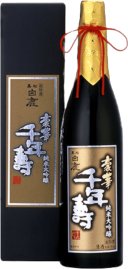$50 to $100
Hakushika Chotokusen Kuromatsu Goka Sennenju Junmai Daiginjo Japanese Sake
This is an elegant representation of Nishinomiya Sake at its finest. This sake has aromatic beginning and smooth finish full of finesse.
Hakkaisan "Eight Peaks" Junmai Ginjo Japanese Sake
Warmth of sunshine on a clear day in cold winter mellows the snow is what this Sake express. This make you enjoy the mellow essence of tasty rice.
Tatenokawa JunmaiDaiginjo Utsukushiki Keiyu
Made with the sake rice variety Miyama Nishiki, cultivated by our own sake rice research institute, this is a sake that shows off the best characteristics of the rice: a deep sharp citrus like acidity. A slightly reserved nose lends itself to an expansive rustic flavour. A clean sake with a good balance of acidity that pairs well with all type of food.
Tatenokawa JunmaiDaiginjo Shield Soubei Wase
"Soubei Wase'' is a native variety of the Shonai region of Yamagata Prefecture, which is the parent of ``Kamenoo'', which is called the ``phantom sake rice''. It is more rare than ever. The logo mark, which combines the family crest of the brewery family, “Genjisha” and “shield,” expresses the intention to continue to protect what has been handed down.
Tatenokawa Junmai Daiginjo Shield Kameno O Namazake
"Kamenoo" is a variety called "phantom sake rice" discovered in 1893 (Meiji 26) by Tokunoka Abe, a current farmer in Shonai Town. Using that "Kamenoo", it was brewed with a special preparation formula that was done at the time of the founding of Tategawa Sake Brewery, which was to fill the pumped water (reduce the proportion of water used during preparation). .. The scent is a little more modest than the general Tatenogawa series. It tastes good, the acidity tightens the taste, and it doesn't feel as sweet as the value of sake. The elegant aroma is suitable for sake during meals, and it is finished as a liquor with a core that has an excellent balance of sweet and acid.
Tatsuriki Tokubetsu Junmaishu Dragon Red
This is a sake that shows its true value when warmed up. It is a dry junmai sake that was born from this concept and has a thick and deep taste from Yamadanishiki rice. Goes well with Japanese dishes using dashi stock such as oden, hot pot, grilled fish and cheese dishes.
Akashi-Tai Junmai Daiginjo Genshu
One of the finest luxury sakes around,this medium-bodied hand-made artisan sake is produced using fine highly-prized Yamadanishiki rice grown in a district of Hyogo. Polished to the highest leve until only 38% of the grain remains, it is fermented in small batches for two months. The complex nose exhibits nuances of melon, lemon, bitter orange and green grass. The palate is superbly balanced with crystallised notes of tropical fruit and citrus with a thread of subtle umami on a long-lasting finish.
Yoshinogawa Yuzu Sparkling Sake
Established in 1548, Yoshinogawa is located in the Niigata Prefecture in the small city of Nagaoka City and, is now in the hands of the 20th generation of the Kawakami Family. It is 5th oldest existing Sake brewery in Japan. Yoshinogawa is one of the largest sake producers in the Niigata prefecture which is a well known major premium rice producing area. Yoshinogawa is also the oldest sake producer in Niigata. The region is a known for its crisp, clean sake with a dry finish. Refreshing sparkling Sake with the addition of Japanese Yuzu juice. It shows the citrus aromas of Yuzu and grapefruit and the palate is elegant. The gentle bubbles, burst with Citrus fruits and just a hint of bitterness to balance the clean finish.
Tengumai Yamahai Jikomi Junmai Sake
Founded in 1823, Tengumai Shuzo is located facing the Japan Sea in the Ishikawa prefecture of central Japan. They produce traditional Yamahai sake using Gohyakumangoku rice. Tasting note: Shows a bright, medium lemon colour in the glass. Not an overly aromatic nose, but what's there works well, showing ripe green fruit of nashi pear and custard apple, yellow melon, and notes of yoghurt and rich rice. On the palate this sake has great texture and umami feel, while showing flavours of green melon, honey, meringue and yoghurt. The richness and weight on the palate work well here. Serve cold or warm. Alc 15.9% SMV: +4 Rice Polishing: 60%
Yoshinogawa Yuzushu Citrus Liqueur
This Yuzushu is a blend of Yuzu juice with sake. Yuzu is a citrus fruit grown in Japan. Yuzushu is sweet and will show some cloudiness from the yuzu infusion. This is normal and best to shake the bottle before serving. Enjoy this liqueur with desserts such as ice cream or cakes.










